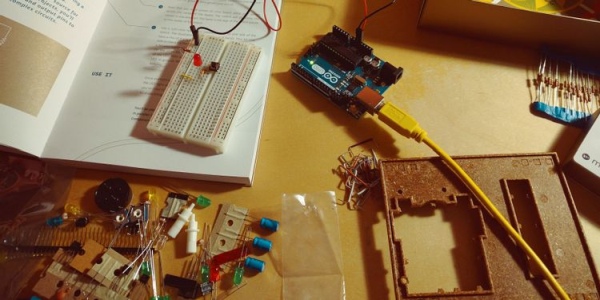Use biometric sensors for your DIY Arduino projects and impress your friends.

While we’re used to seeing medical devices in hospitals, it is now possible for hobbyists like you to add biometric sensors to your DIY Arduino projects with ease. In fact, there are a variety of sensors available on the market you can use for your biometric projects.
Here is a list of eight Arduino-compatible biometric sensors that are easy to set up and will make your projects way cooler.
1. Optical Fingerprint Reader
Integrating fingerprint identification into your projects is made simple with this Arduino-compatible optical fingerprint sensor. As its name implies, the device essentially takes optical images of your fingerprint. It then evaluates the light and dark regions of the captured image to recognize distinct patterns.
To use the sensor, simply connect it to your Arduino via TTL Serial and use any available libraries online to enroll and read your fingerprint. With the module set up and programmed, you can now use it for triggering other devices, such as locks in safes and doors.
2. Pulse Sensor
As a plug-and-play module, the Pulse Sensor is one of the easiest ways to add live heart-rate data to your Arduino projects. It integrates an optical sensor with an amplifier and a noise cancellation circuit to measure the change in light caused by the capillary blood vessel expansion.
The best part is that the sensor is incredibly easy to set up as it only needs three pins (an analog data pin, VCC, and GND). Plug it into your Arduino with some jumper cables, place your finger on the heart logo on the front of the sensor, and you’re all set to read your heart rate!
3. MAX30102 Pulse Oximeter and Heartrate Sensor
Featuring a pulse oximeter and heart rate monitor in a single sensor, MAX30102 is one of the best ways to integrate health monitoring in your Arduino project.
This tiny sensor measures the magnitude of infrared (IR) and red light reflected by the blood to determine the oxygen saturation in it. By analyzing the time series response of these reflected IR and red lights, the heart rate can be calculated, as well.
The MAX30102 Pulse and Heart Rate Sensor features two LEDs (red and IR) and a photodetector that detects both visible and IR light. It communicates with your microcontroller through an I2C digital interface and is ultra-low power, making it ideal for Arduino wearable projects and other mobile applications.
4. AD8232 Heart Rate Monitor
This low-cost AD8232 Heart Rate Monitor can be used to record electrocardiograms (ECGs) on the go. It measures the electrical changes generated by cardiac movements, allowing you to monitor your heartbeat.
These electrical signals can be captured through three electrodes placed on your left and right arms and right leg. The AD8232 sensor then extracts, amplifies, and filters the signals to produce a voltage readable by Arduino and any other microcontrollers.
Although the AD8232 Heart Rate Monitor isn’t as powerful as the electrocardiograms found in hospitals, it can still provide some helpful information for basic heart monitoring. Turn it into a portable ECG to enhance your bike rides or other physical activities and get a quick insight into your heart rate.
5. Galvanic Skin Response Module
A galvanic skin response (GSR) sensor is a cool module you can use to measure a person’s emotional spikes. When experiencing strong emotions, your sweat glands go into overdrive. This increases the sweat you produce, which, in turn, changes your skin’s electrical conductance.
The GSR sensor detects this abrupt change in electrical conductance through two electrodes attached to your fingertips. It interprets this change and eventually generates an analog signal for your Arduino to read.
Because the GSR sensor can essentially detect a change in someone’s physiological state, one of the most common (and fun) applications of the GSR sensor is for lie detectors. It is also an interesting addition to other emotion-related projects, such as sleep quality monitors.
Source: 8 Arduino-Compatible Biometric Sensors for Hobbyists
